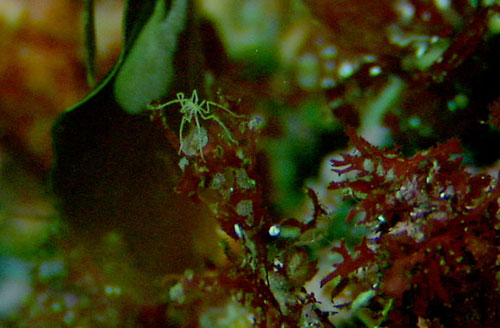
Contact
Biological mapping
Børge Holte
+47 77 60 97 53
Geological mapping
Terje Thorsnes
+47 73 90 42 75
Bathymetry
Hanne Hodnesdal
+47 51 85 88 23
Information officer
Beate Hoddevik Sunnset
+47 55 23 85 16

Published: 27.09.2010 Updated: 18.08.2022
We like to thank Maria Kaurin, guest and student on the MAREANO 2010112 survey for her English translating of the text.

Figure 1. "G.O. Sars" leaving Troms III where we have mapped the marine life and sea bottom north of Arnøya (can be seen in the background) in Troms. We are now continuing on to Nordland VI.
During the past few days we have visited a large shallow area, Alangstaren, north of Arnøya. Alangstaren (figure 2), a familiar name to local fishermen, is a part of this shallow area which is situated at the western edge of Lopphavet. The rocks exposed on the seafloor here are old, and made up by the same hard type as we find on the mainland and nearby islands. It is therefore more difficult to erode these rocks, than the softer sedimentary rocks occurring at deeper water both east and west of Alangstaren. Under periods with lower sea level large waves eroded the rocks, and several times the area experienced the wear and tear of glaciers. Imaging that we travel one million years back in time, then Alangstaren was probably the westernmost island in Lopphavet.

At Alangstaren we conducted a video transect which started at 27 m depth. The kelp forest reached down to 37 m depth. The leaves of the kelp were covered in white spots consisting of the moss like animals known as Bryozoa. These colonies grow in all directions and as a result of this end up with a more or less circular appearance (figure 3).

On the sea floor between the kelp leaves we found common sea stars (Asterias rubens) (figure 4), bushy bryozoans, worms living in calcareous tubes (Sepulidae polychaeta), and red algae.

We also encountered spiders in the kelp forest (figure 5). However, these spiders are not like the ones we know from terrestrial systems, but sea spiders (Pycnogonida). The sea spider mainly consists of legs. The main body is so small that several of the organs are actually placed in the legs. The sea spiders are usually between 1-10 mm long, but in deeper water some individuals can attain a body length of up to 6 cm and a distance of up to 75 cm between the legs. Many sea spiders are predators that live of bryozoans, hydroids, soft corals, sea anemones and sponges. The kelp forest can therefore provide many food sources for the sea spider.

Just south of this shallow area, during our last video transect at Troms III, we discovered a sea bottom covered by several hundred brittle stars per square meter (figure 6). It is not highly unusual to find enormous densities (up to 10,000 individuals per square meter) of, among others, Ophiothrix fragilis at larger depths.

This transect showed a low diversity of animals. One can therefore speculate on what kept all the brittle stars alive. Brittle stars are a diverse animal group which can be predators, scavengers, detrivores or filtrate food particles out of the water current. While studying the species at close range by zooming in with the camera, we saw a crustacean swim straight into the arm of a brittle star. The brittle star reacted instantly and captured the crustacean with its arm and pulled it under its central disc where its mouth is located. One moment later the brittle star had entered the same position we often sea in common sea stars, the prey was held in place under the oral disc by all five arms while the mouth was used for ingesting the prey (figure 7). This may be the first time this behaviour is captured on film for the brittle star species Ophiothrix fragilis.

The fact that one of the brittle stars had captured a prey was immediately noticed by the neighbouring individuals. They drew closer while touching the lucky hunter with their arms. A short while later the hunter was completely covered by the other brittle stars (figure 8).

Stone corals (figure 9) and gorgonian corals (figure 10) were also found at the same transect. The deep sea coral reefs found in our waters has a lot in common with the coral reefs in shallow water in warmer areas. They are made up of stone corals and is the home to an amazingly variety of animals. In Norway the reefs are formed by the species Lophelia pertusa. It is possible to read a lot more about corals and coral findings at MAREANOs website.

